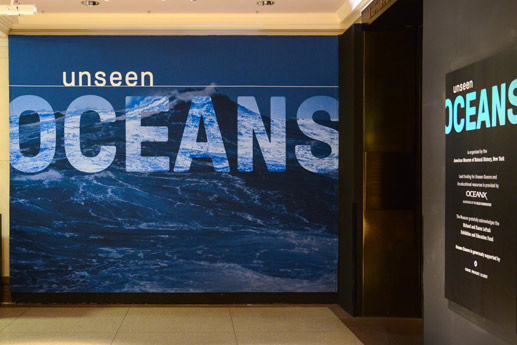Unseen Oceans opens at COSI

COLUMBUS, OH – Our world is truly an ocean planet. More than 70 percent of the Earth’s surface is covered by oceans, yet surprisingly little of these vast realms has been explored. Now, with the use of 21st-century technologies like robotics, ROVs and AUVs, satellite monitoring, miniaturization, and high-definition imaging, that is beginning to change. In Unseen Oceans, an exhibition produced by the American Museum of Natural History, visitors will embark on a journey that takes them from the oceans’ sunlit surfaces to their inky depths as they discover the latest ocean science and encounter the researchers and technologies that are revealing our blue planet as never before. Unseen Oceans opens at COSI in the American Museum of Natural History Special Exhibition Gallery on October 19, 2019 and will be on display through February 2, 2020.
“COSI is thrilled to be the first venue outside of the American Museum of Natural History to host this exhibition,” said Dr. Frederic Bertley, President and CEO of COSI. “Unseen Oceans will give our guests the opportunity to learn more about our oceans and the exciting work in STEM that is leading to new discoveries in and about them. Guests will even get to explore the work of scientists right here in Ohio who are changing the way we look at the oceans around us.”
In Unseen Oceans, visitors will explore a series of circular, media-rich galleries showcasing a range of marine environments and introducing the scientists who are using cutting-edge research tools and developing new methods to explore the oceans top to bottom. How do blue whales spend their day? (High-tech, removable tags on their backs provide the answer.) What’s going on in the deep waters surrounding Hawaii? (Hint: Advanced sonar reveals a new island is set to emerge—in more than 100,000 years.) How can we identify the best locations for marine protected areas? (Fleets of small autonomous robots may offer important clues.) Visitors to Unseen Oceans will learn the answers to these exciting questions and explore other novel lines of inquiry that ocean researchers have only recently uncovered.
“Throughout the two decades that I’ve spent studying the world’s oceans, I’ve been continually astonished at the ingenuity of my fellow marine scientists as they’ve utilized and adapted the latest technologies to make discoveries that we could previously only dream of,” said John Sparks, curator in the Department of Ichthyology at the American Museum of Natural History and curator of Unseen Oceans. “For example, only recently did my colleagues and I reveal the widespread incidence of biofluorescence—the phenomenon by which organisms absorb light, transform it, and emit it as a different color—among marine fishes. Visitors to this exhibition will learn about that research and more as they meet the scientists who are quite literally illuminating the unseen frontiers of our ocean world.”
The exhibition includes:
• a projection of waves lapping at visitors’ feet and a vista of the water’s surface;
• larger-than-life models of unusual and beautiful planktonic species;
• fascinating casts of fossils from Earth’s past—from ammonites to megalodon teeth;
• a 180-degree, high-resolution screen where animations of blue whales, giant squid, and manta rays swim by visitors at true-to-life scales;
• a scientifically-accurate re-creation of an undersea landscape from the Galápagos seamount chain;
• a prototype of the latest soft robotics that engineers are developing to help marine biologists sample and analyze inhabitants of the deep sea with minimal damage;
• an immersive submersible theatre, where visitors will experience a thrilling, virtual ride from the surface to inky depths;
• digital interactive submersible stations, allowing visitors to “drive” a virtual submersible, navigate around seamounts, and make discoveries of their own;
and a partial replica of a Triton submersible, providing a great photo opportunity for those with their cameras at the ready.
Visitors will also learn about the work of climate scientists who are searching for strategies to help wildlife cope with a warming world as well as learn about the newest generation of explorers who are continuing to expand our view of marine ecosystems and working to uncover the many mysteries that still remain in our ocean planet.
Unseen Oceans is organized by the American Museum of Natural History, New York (amnh.org). Unseen Oceans is curated by John Sparks, curator in the American Museum of Natural History’s Department of Ichthyology in the Division of Vertebrate Zoology. For more information visit cosi.org.